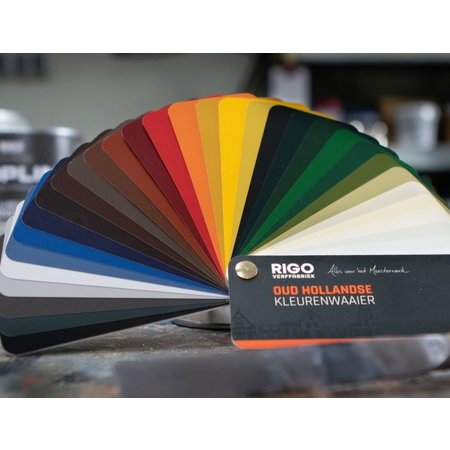Rigo Old Dutch color fan
| Article number: | 13049 |
- Mo/Fr ordered before 18.00 is shipped directly
- Laagste prijs tot wel 75% korting !
- Houtafwerkingsspecialisten sinds 1976
- Grootste voorraad van de Benelux (+1000m2)
- Reeds 200.000+ tevreden klanten
- Customer service from 10:00 to 18:00
Aquamarine Old Dutch color fan with the current old Dutch colors on it so that you can make a choice from this, this can be mixed by color in Edel or another Evert Koning paint or all Aquamarine paints.
Consisting of, among other things,
Black no. 100
Ocher no. 105
Dark brown no. 108
English Red no. 125
White no. 200
Off White no. 201
Sandstone no. 204
Yellow no 315
Signal red no. 325
Oxblood no. 328
Zaans green no. 335
Medium blue no. 345
Dark blue no. 347
Canals Green no. 338
Our updated Old Dutch color range is here! This fan shows the 32 most beautiful colors from RIGO color collections since 1938, eighty years of color history is bundled in this "new" Old Dutch color fan. These classic colors belonging to Dutch heritage have determined the typical authentic character of Dutch monuments for years.
Linseed oil stand paint is on the rise. On the one hand thanks to its vegetable and renewable properties, and on the other hand thanks to its unsurpassed technical qualities. It is not without reason that layers of linseed oil paint hundreds of years old are still found in monumental work and are still completely intact. Monuments require linseed oil paint, which has proven itself as a protector of wood for hundreds of years.
What colors can you find in this collection? Of course the classic Heerengrachtengroen and Standwit, but also Oer Rood from the Groningen landscape and, for example, Camperduins Groen from the Schoorlse dunes. Further back in time, Indian Yellow was brought from the East and used to make a warm orange paint. And Umbridge Gray, a dark gray with the yellow tones of umber, certainly does not look out of place in a contemporary street scene.
Heerengrachtengreen is traditionally, as the name suggests, the color that was applied to Heerenhuizen on the canal in the city. Green was an expensive color because it was made from blue and yellow. The blue pigment was the most expensive pigment available. The yellow pigment was less colourfast and slowly faded from the colour, leaving the paint with a blue glow. With such a dark green color on your front door you could radiate grandeur and wealth.
On the other hand, in the 1950s you saw our youngest heritage in the Flevopolder being painted in pale brown tones: cheaper colors that matched the scarcity at the time of reconstruction.
This fan is an ode to the craftsmanship of painters and the high quality and durability that comes with it. In a fan, colors are of course always only an indication, because in the oily, convex shine of the TOPLIN Linseed Oil Stand Paint the colors are much deeper.







